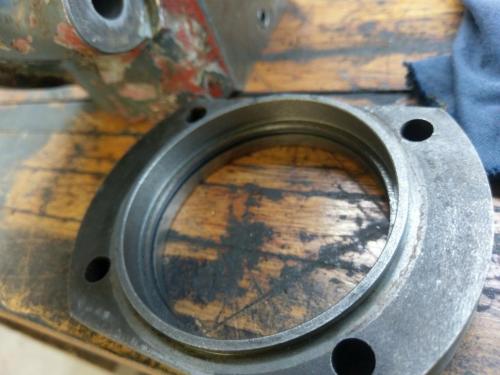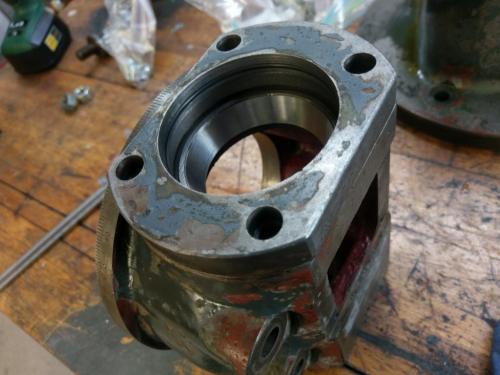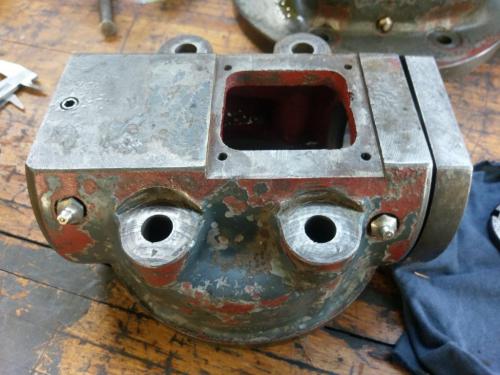03-02-2017, 02:35 AM
One of the jobs I have been wanting to do for ages is to renew the spindle bearings in the vertical attachment of my Victoria U2 mill. Whenever I have used it, the bearings have run quite hot and the grease has oozed down the outside of the spindle and sprayed everywhere plus dripped onto the work. I dismantled it last week and ordered new bearings, picked them up yesterday and began reassembling.
There is no actual seal at the bottom end of the spindle, just what appears to be an O-ring groove enabling an O-ring to run on the rotating spindle, this seems all wrong to me but it's the only thing I can figure the groove is for.
Here's the spindle sitting in the housing as viewed from below without the lower cover. The shiny surface is where the O-ring will run.
 spindle lower bearing.jpg (Size: 22.66 KB / Downloads: 81)
spindle lower bearing.jpg (Size: 22.66 KB / Downloads: 81)
This is the lower cover, I have fitted an O-ring into the groove.

The lower cover in place with the spindle out of the way.

I would love to be able to machine the cover out to take a proper lipped seal but this photo shows how there is not sufficient wall thickness on one side to do that.

The housing has a grease (or oil) nipple for each bearing.

I pulled this vertical attachment apart and cleaned out the ancient grease when I first got the machine, I repacked it with wheel bearing grease and installed an O-ring that I had in stock, the O-ring was a bit of a loose fit. I knew that the bearings were not in great condition but decided to see how they went. As mentioned, grease has just run right out of the thing whenever it got warm. Hopefully the new bearings will run at a cooler temperature, also I have sourced an O-ring that is a more snug fit. I have been trying to source some NGLI 3 grease to pack the thing with so that it has less tendency to drip out but have so far been unable to find it in less than 20kg.
I'm very uncomfortable with the idea of an O-ring as a seal on a rotating shaft, just can't see that it will work. I'm open to suggestions on how to solve this problem, I'd like to keep the vertical attachment in place most of the time now that I have the power Z-axis feed working.
There is no actual seal at the bottom end of the spindle, just what appears to be an O-ring groove enabling an O-ring to run on the rotating spindle, this seems all wrong to me but it's the only thing I can figure the groove is for.
Here's the spindle sitting in the housing as viewed from below without the lower cover. The shiny surface is where the O-ring will run.
 spindle lower bearing.jpg (Size: 22.66 KB / Downloads: 81)
spindle lower bearing.jpg (Size: 22.66 KB / Downloads: 81)
This is the lower cover, I have fitted an O-ring into the groove.
The lower cover in place with the spindle out of the way.
I would love to be able to machine the cover out to take a proper lipped seal but this photo shows how there is not sufficient wall thickness on one side to do that.
The housing has a grease (or oil) nipple for each bearing.
I pulled this vertical attachment apart and cleaned out the ancient grease when I first got the machine, I repacked it with wheel bearing grease and installed an O-ring that I had in stock, the O-ring was a bit of a loose fit. I knew that the bearings were not in great condition but decided to see how they went. As mentioned, grease has just run right out of the thing whenever it got warm. Hopefully the new bearings will run at a cooler temperature, also I have sourced an O-ring that is a more snug fit. I have been trying to source some NGLI 3 grease to pack the thing with so that it has less tendency to drip out but have so far been unable to find it in less than 20kg.
I'm very uncomfortable with the idea of an O-ring as a seal on a rotating shaft, just can't see that it will work. I'm open to suggestions on how to solve this problem, I'd like to keep the vertical attachment in place most of the time now that I have the power Z-axis feed working.
Lathe (n); a machine tool used in the production of milling machine components.
Milling Machine (n); a machine tool used in the production of lathe components.
Milling Machine (n); a machine tool used in the production of lathe components.






